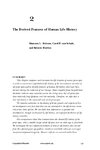TO
1 - 25 of 6
| Creator | Title | Description | Subject | Date | ||
|---|---|---|---|---|---|---|
| 1 |
 | Broughton, John | Fish remains dominate Barn Owl pellets in northwestern Nevada | The foraging ecology of the Barn Owl (Tytoalba) has been studied extensively, both in the New World (Marti 1988, Castro and Jaksic 1995, Van Vuren and Moore 1998, and others) and the Old World (Glue 1967, Yom-Tov and Wool 1997, and others). Small rodents, insectivores, and small birds are generally ... | Barn owl pellets; Northwestern Nevada; fish; fish remains | 2006 |
| 2 |
 | O'Rourke, Dennis H. | Hrdlič̌ka's Aleutian population-replacement hypothesis: a radiometric evaluation | In a 1945 monograph, Hrdlička argued that, at 1,000 BP, Paleo-Aleut people on Umnak Island were replaced by Neo-Aleut groups moving west along the island chain. His argument was based on cranial measurements of skeletal remains from Chaluka Midden and mummified remains from Kagamil and Ship Rock b... | Population replacement; Paleo-Aleuts; Neo-Aleuts | 2006 |
| 3 |
 | Hawkes, Kristen | The derived features of human life history | This chapter compares and contrasts the life histories of extant great apes in order to construct a hypothetical life history of the last common ancestor of all great apes and to identify features of human life history that have been derived during the evolution of our lineage. Data compiled from th... | 2006-01-01 | |
| 4 |
 | Cashdan, Elizabeth A. | Ethnocentrism and xenophobia: a cross-cultural study | Analyzes the factors influencing ethnic affiliation and interethnic hostility. Relationship between intraethnic loyalty and risk of famine; Continuity of violence at different levels of groupings; Analysis of local and intercommunity conflict. | Ethnic relations; ethnology | 2006-06-06 |
| 5 |
 | Rogers, Alan R. | How much can fossils tell us about regional continuity? | Presents a study on the genetic contribution of earlier populations to later populations within regions called regional continuity. Testing for regional continuity with multiple characters; Replacement of archaic population by a population of modern humans. | Human genetics; Fossils; Regional continuity | 2006-06-05 |
| 6 |
 | Hawkes, Kristen | Life history theory and human evolution : a chronicle of ideas and findings | Fertility ends at similar ages in women and female chimpanzees, but humans usually live longer and mature later. We also differ from our closest living relatives in weaning infants before they can feed themselves. The comparisons pose questions about when and why the distinctively human life history... | 2006-01-01 |
1 - 25 of 6
